Laying of sewer pipes in the ground
To lay pipes of the sewage system in a private house, including in the ground, is an easy task. There is no need for any special skills or special equipment. If you understand all the subtleties, then practically anyone can handle the task. The main thing is to remember that communications will be adversely affected by moisture, aggressive media, and the pressure of the ground itself.
Which pipes are better to use?

Today on sale you can find a large range of products designed to create sewage systems. And which pipe is preferable when laying in the ground? On this issue, expert opinions may differ. Therefore, it is desirable to get acquainted with all the options.
More recently, cast iron, concrete or asbestos-cement pipes were used for laying sewage in the ground. Today, such models are practically not used, as they are rather cumbersome, difficult to install and short-lived.
The most popular for sewer pipes are plastic products. These include pipes from:
- PVC (polyvinyl chloride);
- PP (polypropylene);
- PE (polyethylene).
All of them are great for laying in the ground. But there are some nuances. For example, if pipes will experience increased load (for example, when laying under a road), then it is better to purchase products made of PP and PE.
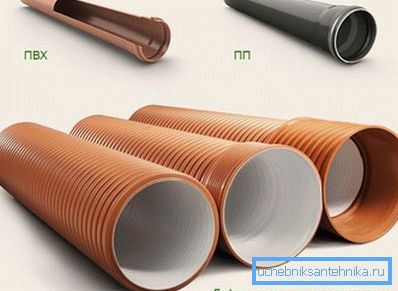
In addition, buying pipes for outdoor sewage, pay attention to the color. For these purposes are products having an orange color. They better tolerate increased mechanical loads and chemical effects.
There is another type that can be used for laying external sewage into the ground - these are products made of fiberglass. They are reliable and durable, but heavier than plastic, and they are more expensive.
Therefore, if we make a generalization, then the best option is to use polypropylene or polyethylene pipes. As a rule, models with a diameter of 110 mm are used for the outdoor waste collection system. It is also advisable to buy pipes with a corrugated surface, as they are better tolerated by mechanical loads.
Excavation
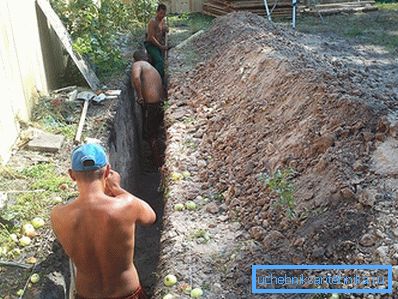
The technology of laying sewer pipes is quite simple. The first thing to dig trenches. Then they are laid pipe. Everything connects. The final step will be to backfill the trenches. But all this in theory, in practice, there may be some difficulties.
First, it is first necessary to draw up a plan for laying sewers. It indicates the point of exit from the house and the end point of the system (the entrance to the main sewage system or to the septic tank). Between these points a route is laid for the location of the pipes. It is better that he was straight or with a minimum number of turns. Remember that every bend is a potential place of blockage.
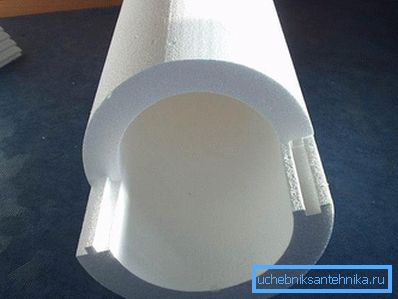
Only then can you mark up the terrain and begin excavation work. The width of the trenches should be at least the spade bayonet, (with a large depth of pipe laying the size increases to 0.6 meters) and the depth should be done with a margin to create a cushion. All work can be done manually or hire an excavator.
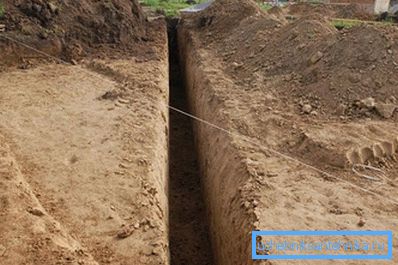
When carrying out excavation work, do not forget to dig out the pits for manholes. They are necessary for ease of maintenance (cleaning) of the system. Such structures must be installed in places where the road turns. If all pipes are laid in a straight line, then manholes should be installed every 12 meters.
Laying and installation of sewer pipes

Now go directly to how to lay the pipe under the ground. In the trench begin to lay the pipes and connect them. The laying rules are quite simple:
- should start from the point of exit of the sewer from the house;
- when laying pipes, the branch pipes should be located from the end that looks towards the septic tank (or points of connection to the main sewage system);
- Before connecting, make sure that there are no foreign objects in the pipe;
- the socket and the straight end of the pipes must be cleaned of dirt and lubricated with a special compound.

If you install the manholes, then they are better to buy ready-made. Such plastic structures are equipped with all inlet and outlet openings, and docking them with the pipes of the system is easy. If you do the manholes yourself, then provide a place to enter and exit the sewer. This can be done by placing a thick metal pipe into the walls during concreting or erection of brickwork.
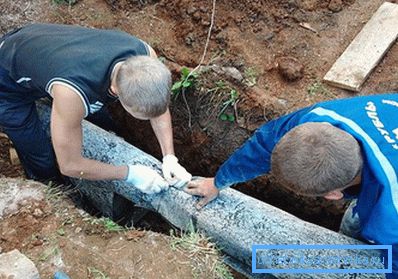
When laying the pipe above the level of soil freezing, it is desirable to produce insulation. For this you can use any insulating material. It is very important that the insulation does not give in to rotting, otherwise next year your waterproofing will become unusable. Heat insulation material is simply wrapped around the pipes.
Today you can find a special insulation, which is made in the form of a cover for pipes. During installation, its two halves open, and a sewer pipe is inserted inside. Such material is made of polymers, it is not afraid of moisture, and also not subject to rotting.
Trenching
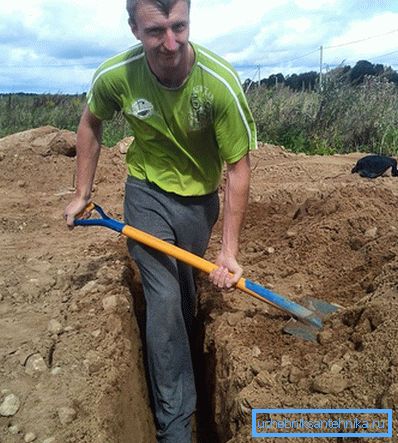
After connecting all the details you can proceed to the last stage - backfilling of trenches. But before that you should check the correctness of the slope. To do this, a small amount of water is poured into the system and the rate of its passage through the entire system is traced. If the slope is correct (water quickly fell into a septic tank or central sewer), then proceed to the backfill.
To fill the trench, you can use the excavated soil. But before that, it is necessary to sift it, or rather, to remove large stones and hard lumps of earth. If fractions larger than 30 mm fall on the pipe, in this case the communications may be damaged. Many experts recommend the first 20-30 cm to fall asleep with sand, and then use the soil.
During filling it is necessary to tamp the ground. This is done every 5 cm. At the same time, at the initial stage it is necessary to ram only on the sides, where there is no pipe. As soon as a layer of 30–40 cm is covered, it is possible to tamp over the entire surface.
Video
Advice on the recommendations of experts who will tell about the use of pipes for external and internal sewage systems:
This video describes how to properly lay sewer pipes on a plot near a country house: